Scottish Health Survey – telephone survey – August/September 2020: main report
Presents results for the Scottish Health Survey – telephone survey- August to September 2020, providing information on the health and factors relating to health of people living in Scotland.
This document is part of a collection
Chapter 4: Diet, Obesity & Food Insecurity
This summary covers data collected between the 5th August 2020 and the 23rd September 2020.
Among all adults, the most commonly consumed discretionary foods were:
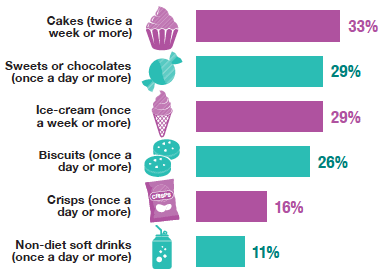
Just over a third of adults were within the healthy weight range◊.
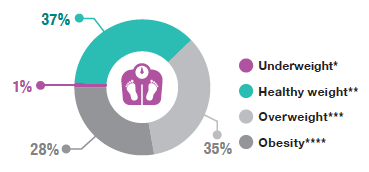
Mean BMI‡ was highest among those aged 45-74.
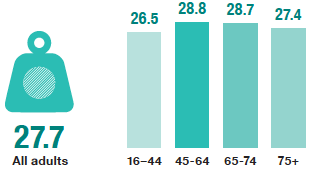
Prevalence of overweight (including obesity)† was higher among those aged 45 and over.
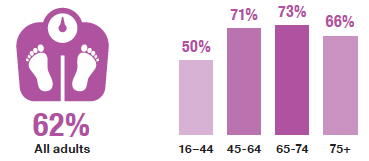
Just over half of adults reported changes to their weight between the start of lockdown†† and the date of the interview.
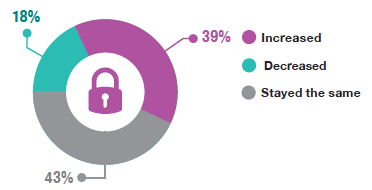
Women were more likely than men to report that their weight increased since the beginning of lockdown††.
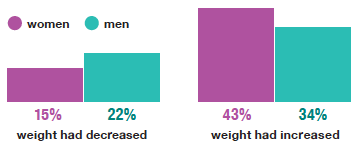
Food insecurity††† was more prevalent among younger adults.

◊Due to rounding the percentages do not add up exactly and exceed 100%.
*BMI of less than 18.5 kg/m2
**BMI of 18.5 to less than 25 kg/m2
***BMI of 25 to less than 30 kg/m2
****BMI 30 kg/m2 and over
‡The BMI calculations have been adjusted on the basis of work undertaken previously on the Health Survey for England (see technical report for more information).
†BMI 25 kg/m2 and over
††Lockdown began on the 23rd March 2020.
†††Worried would run out of food in the last 12 months because of a lack of money or other resources
4 Diet, Obesity & Food Insecurity
Joe Rose
4.1 Introduction
Globally, poor diet is a leading risk factor for ill health[1] while obesity has been linked to a range of comorbidities including diabetes, cardiovascular disease (CVD), hypertension and certain cancers[2,3]. Such conditions could be prevented and/or the risk reduced by improvements in the nutritional content of diets (increasing fruit and vegetable intake[4], decreasing salt, saturated fat and sugar[5]) and overall reductions in body mass[6]. Research also suggests a reciprocal link between obesity and mental health problems such as depression and anxiety[7,8,9]. More recently, evidence suggests excess weight is associated with an increased risk of serious COVID-19 outcomes[10].
A ‘whole system approach’, including eating well, maintaining a healthy weight and regular physical exercise, is a key public health priority for Scotland. A Healthier Future: Scotland’s Diet and Healthy Weight Delivery Plan[11], published in July 2018, sets out a wide range of actions that support people to eat well and maintain a healthy weight, while reducing diet-related inequalities.The Scottish Dietary Goals, revised in 2016[12], provide the basis for a healthy balanced diet that include meeting the World Health Organisation 5-a-day recommendation for adults and reducing average salt, red meat, fats, sugars and total carbohydrate intake. Alongside these, the Scottish Government is committed to monitoring household food insecurity[13] and have committed over £130 million to tackling food insecurity since the onset of the pandemic. This is underpinned by a cash-first approach and bolstered further through investment to tackle financial insecurity, including through the Scottish Welfare Fund.
Evidence is suggestive of varying impacts of the pandemic on diet and physical activity, with both positive and less beneficial actions adopted by individuals in response to their own and national circumstances, sometimes interchangeably[14]. Several reports have also highlighted the negative impact on food insecurity and the widening of existing inequalities with an 89% increase in demand for emergency food parcels in the UK in April 2020 compared with the same period in 2019 and foodbank demand more than doubling during the same period[15].
This chapter presents findings on the eating habits of adults in the Scottish population in August/September 2020, body mass index (BMI)[16], and self-reported changes in weight since the start of the lockdown period, as well as on food insecurity. Information on methods and definitions can be found in Volume 2: Technical Report.
4.2 Diet, Obesity And Food Insecurity
The fieldwork period referenced in the following analysis covers from the 5th August 2020 to the 23rd September 2020.
In interpreting these results, note that, in the usual format of the Scottish Health Survey, interviewers undertake height and weight measurements. As this was not possible in the telephone survey, respondents were asked to provide these measurements themselves. Other studies have shown that self-reported measurements tend to overestimate height and underestimate weight on average. To help address this, adjustment factors based on a comparison study undertaken for the Health Survey for England were used to adjust the self-reported measurements. However, for women, levels of overweight including obesity tend to be higher in deprived areas where response to this survey was lower than usual (the pattern for men is less clear), hence the results in sections 4.2.2 and 4.2.3 may underestimate true prevalence.
While consumption of discretionary foods tends not to show a clear pattern by deprivation, consumption of non-diet soft drinks has been reported to be higher in deprived areas, hence the results in section 4.2.1 may underestimate true prevalence of consumption.
As questions on food insecurity are potentially sensitive in nature, in the usual format of a Scottish Health Survey interview in the home, they are included in a self-completion form which the respondents complete themselves rather than the interviewer asking the questions. Self-completion formats may illicit a more accurate response from some participants who feel more comfortable answering sensitive questions privately. For this reason and as levels of food insecurity are generally higher in deprived areas where response to this survey was lower than usual, the results in sections 4.2.4 and 4.2.5 below may underestimate true prevalence.
See section 1.9.5 of the technical report for further details on diet, obesity and food insecurity.
4.2.1 Summary of adult eating habits, August/September 2020, by age and sex
During the fieldwork period, 33% of all adults reported eating cakes twice a week or more, followed by sweets or chocolates (once a day or more) and ice-cream (once a week or more) (both 29%). These foods were closely followed by consumption of biscuits (26%), crisps (16%) and non-diet soft drinks (11%), all consumed once a day or more.
Men were more likely than women to consume cakes twice a week or more (37% compared with 30% respectively) and ice-cream once a week or more (33% compared with 25% respectively) while women were more likely than men to consume sweets or chocolate once a day or more (32% compared with 25% respectively). No other variations in the consumption of discretionary foods by sex were found.
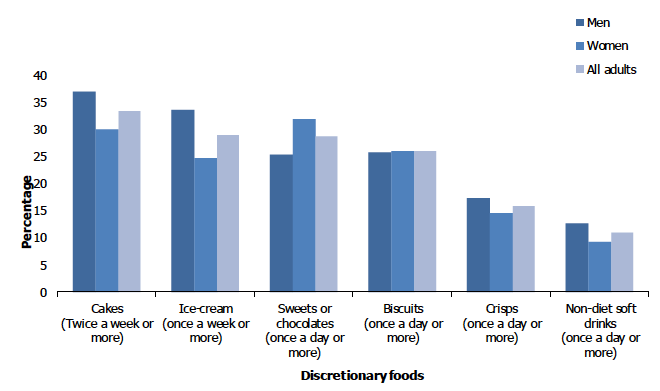
Differences in the consumption of several discretionary foods were evident by age. The proportion of adults consuming crisps once a day or more decreased with age (19% among those aged 16-44 compared with 9% - 10% among those aged 65 and over) as did the proportion consuming non-diet soft drinks once a day or more (15% compared with 5% - 6% respectively). Conversely, increases by age were evident for eating biscuits once a day or more (from 16% of those aged 16-44 to 57% among those aged 75 and over) and for consuming cakes two or more times a week (30% and 47% respectively). The consumption of ice cream (once a week or more) was highest among those aged 75 and over (43% compared to 25% - 32% among those aged 16-74). These trends were consistent for both men and women. The consumption of sweets or chocolates (once a day or more) also varied by age but with no clear pattern.
Figure 4A, Table 4.1
4.2.2 Adult BMI (based on adjusted self-reported measurements[17]), August/September 2020, by age and sex
Just over a third of adults (37%) interviewed during the fieldwork period were within the healthy weight range (BMI of 18.5 to less than 25 kg/m2), with around six in ten (62%) categorised as overweight including obesity (BMI of 25 kg/m2 and over). Men were more likely to be overweight than women (38% and 31% respectively), however, there were no significant differences recorded by sex for the healthy weight category or the prevalence of overweight including obesity.
An association was observed between age and BMI, with those aged 16-44 more likely to be within the healthy weight range than those aged 45 and over (48% compared with 26% - 34% respectively), while prevalence of overweight including obesity was higher among those aged 45 and over than among those aged 16-44 (66% - 73% compared with 50% respectively). Similar patterns by age were observed for both men and women.
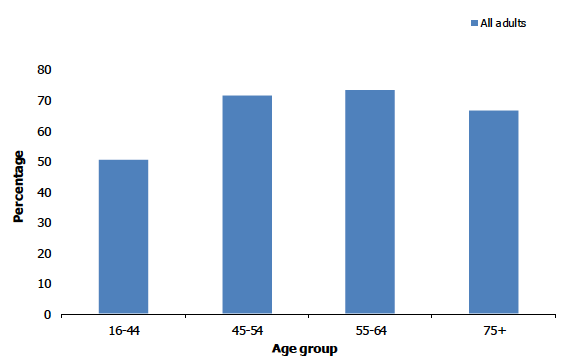
The mean BMI among all adults interviewed during the fieldwork period was 27.7 kg/m2, with no significant difference by sex (27.5 kg/m2 among men and 27.8 kg/m2 among women). Mean BMI varied by age and was lower among adults aged 16-44 (26.5 kg/m2) and those aged 75+ (27.4 kg/m2) than among those aged 45-74 (28.7 – 28.8 kg/m2). A similar pattern by age was found for men and women.
Figure 4B, Table 4.2
4.2.3 Self-reported changes in weight since lockdown began (23rd March), August/September 2020, by age and sex
Just over two fifths of adults (43%) reported that their weight had stayed the same between the start of lockdown (23rd March 2020) and the date of interview, while just under two-fifths (39%) reported an increase in weight and just under a fifth (18%) that their weight had decreased over this period.
Women were more likely than men to state that their weight increased since lockdown began (43% compared with 34% of men) and were less likely to report that their weight had decreased (15% and 22% respectively). Similar proportions of women and men reported that their weight had stayed the same over the period (41% and 44% respectively).
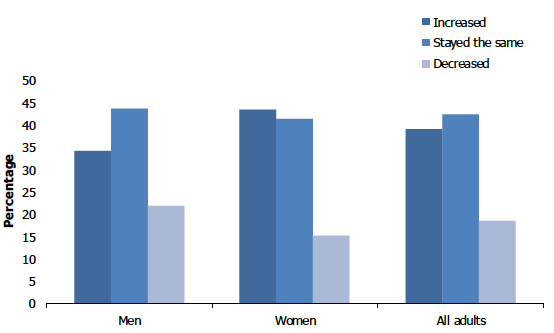
The prevalence of adults who reported that their weight stayed the same since lockdown began increased by age from 39% of those aged 16-44 to 55% of those aged 75 and over. Adults aged 75 and over were less likely than younger adults to report an increase in weight over this period (26% compared with 39% - 42% among those aged 16-74).
Figure 4C, Table 4.3
4.2.4 Self-reported changes in weight since lockdown began (23rd March), August/September 2020, by whether received shielding letter/text and sex
Having received shielding letter/text or not had no significant association with any difference in perceived weight change since lockdown began with 42% and 43% respectively having indicated that there had been no change.
Table 4.4
4.2.5 Adult food insecurity, August/September 2020, by age and sex
During the fieldwork period, just under one in ten adults (8%) reported that they worried that they would run out of food at some time due to a lack of money or other resources, 4% of all adults reported having eaten less than they should and 2% that they had run out of food due to a lack of money or other resources during the previous 12 months.
No significant difference in food insecurity was observed between men and women. However, it was more prevalent among younger adults, with those aged 16-44 (11%) most likely to report having been worried they would run out of food in the previous 12 months (compared to 7% for those aged 45-64 and 1% - 2% for those aged 65 and over).
Younger adults were also more likely than others to report having eaten less over the same period because of a lack of money or other resources (4% - 7% among those aged 16-64 compared with 1% among those aged 65 and over) and to have run out of food due to a lack of money or other resources (2% - 3% of those aged 16-64 compared with 0% among those aged 65 and over). Similar patterns by age were recorded for both men and women, with no significant variations.
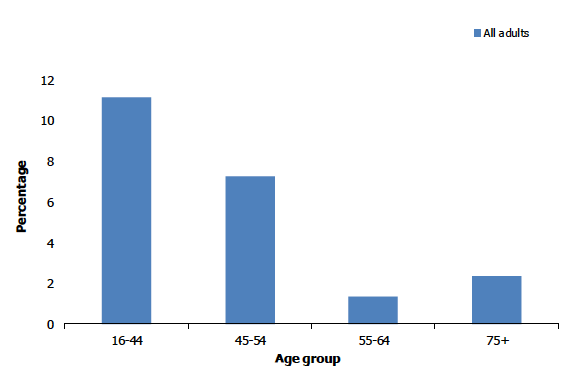
Figure 4D, Table 4.5
4.2.6 Adult food insecurity, August/September 2020, by whether received shielding letter/text and sex
No significant variations in food insecurity prevalence were recorded between those who had been advised to shield and those who had not with 11% and 7% respectively indicating that they had been worried they would run out of food in the last 12 months. Table 4.6
Table List
Table 4.1 Summary of adult eating habits, August/September 2020, by age and sex
Table 4.2 Adult BMI (based on self-reported measurements), August/September 2020, by age and sex
Table 4.3 Self-reported changes in weight since lockdown began (23rd March), August/September 2020, by age and sex
Table 4.4 Self-reported changes in weight since lockdown began (23rd March), August/September 2020, by whether received shielding letter/text and sex
Table 4.5 Adult food insecurity, August/September 2020, by age and sex
Table 4.6 Adult food insecurity, August/September 2020, by whether received shielding letter/text and sex
The tables can be found in the main report page under supporting documents.
References and notes
1. Editorial (2017). Life, Death and Disability in 2016. The Lancet; 390(10100): p1083-1464.
2. Defined in adults as a body mass index (BMI) of 30 kg/m² or greater.
3. Abdelaal M, le Roux, C and Docherty, N (2017). Morbidity and mortality associated with obesity. Annals of Translational Medicine; 5(7): 101: p.1.
4. World Cancer Research Fund/American Institute for Cancer Research (2018). Diet, nutrition, physical activity and cancer: a global perspective. Continuous Update Project Expert Report. Food, Nutrition and Physical Activity and the Prevention of Cancer: a Global Perspective. [Online].
5. Food Standards Scotland. (2018). The Scottish Diet: It needs to change. [Online].
6. World Cancer Research Fund/American Institute for Cancer Research (2018). Diet, nutrition, physical activity and cancer: a global perspective. Continuous Update Project Expert Report. Food, Nutrition and Physical Activity and the Prevention of Cancer: a Global Perspective. [Online].
7. Floriana, S, Luppino, MD, Leonore, M, de Wit, MS, Paul, F, Bouvy, MD et al. (2010). Overweight, obesity and depression: A systematic review and meta-analysis of longitudinal studies. Arch Gen Psychiatry .229-220:)3(67;2010 .doi:10.1001/archgenpsychiatry.2010.2.
8. Gatineau, M, Dent, M (2011). Obesity and mental health. National Obesity Observatory. SCIE Social Care [Online].
9. Rivenes, AC, Harvey, SB, Mykletun, A (2009). The relationship between abnormal fat, obesity and common mental disorders: Results from the HUNT study. Journal of Psychosomatic Research, 66(4): 269-275.
10. Public Health England (2020). Excess Weight and COVID_19: Insights from new evidence. [online].
11. A Healthier Future: Scotland’s Diet & Healthy Weight Delivery Plan, Edinburgh: Scottish Government, 2018.
12. Revised Dietary Goals for Scotland, Edinburgh: Scottish Government, 2016.
13. Dignity: Ending Hunger Together in Scotland - The Report of the Independent Working Group on Food Poverty. Edinburgh: Scottish Government (2016).
14. Ingram, J, Maciejewski, G and Hand, C. (2020). Changes in Diet, Sleep, and Physical Activity Are Associated With Differences in Negative Mood During COVID-19 Lockdown. Frontiers in Psychology.
15. University of Glasgow: Policy Scotland (2020). Evidence round-up: Issues in recovery, food insecurity and learning loss.
16. Based on self-reported height and weight data.
17. The BMI data reported here has been adjusted on the basis of work undertaken previously based on Health Survey for England self-reported height and weight data. Further information can be found in the technical report.
Contact
There is a problem
Thanks for your feedback